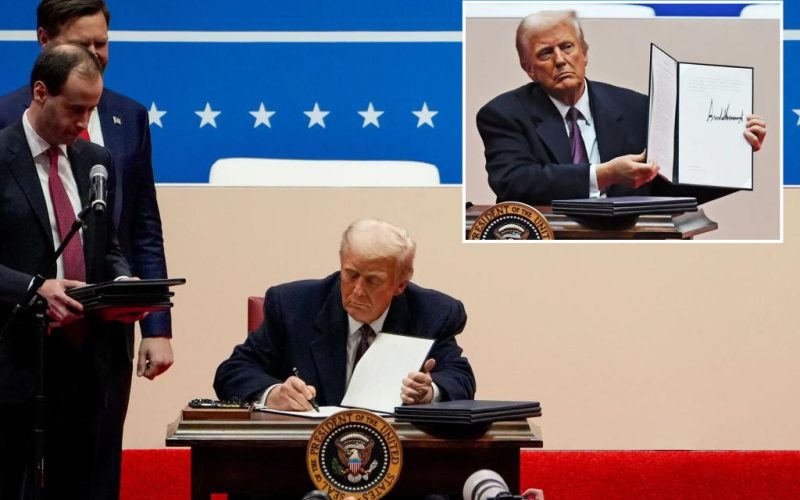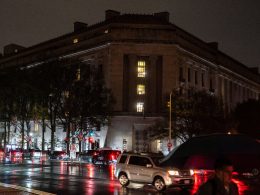President Trump on Monday signed an executive order requiring most federal employees to return to work in person full-time, a move that is likely to spark backlash and legal challenges from unions.
What does Trump’s order do?
Trump directed the heads of all federal agencies to “take all necessary steps to terminate remote work arrangements” and require employees to report to “their respective duty stations” full-time.
The two-sentence order says the directive “shall be implemented consistent with applicable law.”
Can Trump prohibit federal employees from working remotely?
It depends. The president has broad authority over the federal workforce, including the power to tell agencies to stop allowing remote work for employees who are not unionized.
That includes supervisors and managers, who cannot join unions, and Trump could move quickly to order them back to the office.
But about 26% of federal employees are unionized and many are covered by bargaining agreements that allow for remote work or hybrid arrangements.
The Trump administration will have to wait for those to expire or try to renegotiate them.
Bargaining agreements between federal agencies and unions can only be challenged in court if they contain illegal terms or were the product of coercion, bribery or some other wrongdoing.
In some cases, federal agencies may also be required to allow employees with disabilities to work remotely.
President Trump wasted no time signing a slew of executive orders on Day 1, including those that:
- Direct DOJ not to enforce TikTok “divest-or-ban” law for 75 days
- Halt 78 Biden-era executive actions
- Withdraw from the Paris climate accord
- End all federal cases and investigations of any Trump supporters
- Revoke protections for transgender troops
- Pardon about 1,500 people criminally charged in the Jan. 6 attack, while commuting the sentences for six
- Overhaul the refugee admission program to better align with American principles and interests
- Declare a national emergency at the US-Mexico border
- Designate drug cartels and Tren de Aragua as foreign terrorist organizations
- Reverse several immigration orders from the Biden administration, including one that narrows deportation priorities to people who commit serious crimes, are deemed national security threats or were stopped at the border
- Rescind a policy created by the Biden administration that sought to guide the development of AI to prevent misuse
- Rescind a Biden-era policy that allowed federal agencies to take certain initiatives to boost voter registration
- Rescind the 2021 Title IX order, which bans discrimination based on gender identity or sexual orientation in education programs that get federal funding
- Revoke Biden’s recent removal of Cuba from US state sponsors of terrorism list
- Order federal employees back to work in office five days a week
- Order a federal hiring freeze, including exceptions for posts related to national security and public safety and the military
- Direct every governmental department and agency to address the cost-of-living crisis
- Restore freedom of speech and prevent censorship of free speech
- End the “weaponization of government against the political adversaries of the previous administration”
- Impose 25% tariffs on products from Mexico and Canada as of Feb. 1
- Reverse Biden sanctions on Israeli settlers in the West Bank
- Reverse Biden order requiring 50% of new cars sold in 2030 be EVs
- Proclaim that there are two biological sexes: male and female
- End diversity, equity and inclusion programs within federal agencies
- Establish Department of Government Efficiency
- Institute enhanced screening for visa applicants from certain high-risk nations
- Reopen Alaska’s Arctic National Wildlife Refuge to oil and gas exploration
- Order attorney general, secretary of state and secretary of homeland security to “take all appropriate action to prioritize” prosecution of illegal aliens who commit crimes
- Withdraw US from Global Minimum Tax agreement
- Institute a 90-day pause in the issuance of US foreign aid
- Order the attorney general to pursue the death penalty for killing of a law enforcement officer or any capital crime committed by an illegal immigrant
- Order the secretaries of commerce and the interior to restart efforts to route water from California’s Sacramento-San Joaquin Delta to other parts of the state
- Withdraw the US from the World Health Organization
- Order Treasury Department to explore creation of External Revenue Service
- Revoke security clearances for ex-national security adviser John Bolton and 51 intelligence officials who said Hunter Biden laptop bore “classic earmarks” of Russian disinformation.
- Declare the border crisis an “invasion” and order the attorney general and secretaries of state and homeland security to “take all appropriate action to repel, repatriate, or remove any alien engaged” in such
- Formally rename the Gulf of Mexico the “Gulf of America” and Alaska’s Mt. Denali to “Mt. McKinley”
Federal law requires employers to grant “reasonable accommodations” to workers with chronic medical conditions as long as they can still perform their job duties.
How many federal employees work remotely?
The Trump White House said on Monday that only 6% of federal employees currently work in person, but government data show that remote work is more limited.
About 46% of federal workers, or 1.1 million people, are eligible for remote work, and about 228,000 of them are fully remote, according to a report issued by the White House Office of Management and Budget in August.
The US Department of Defense and Department of Veterans Affairs, which have far more employees than other agencies, have the most remote workers, along with the Department of Health and Human Services.
For federal employees who are eligible for remote work, about 61% of regular working hours are spent in person, according to OMB. That figure excludes fully remote workers.
Why does Trump oppose remote work?
Trump’s order may also represent an effort to encourage some federal workers to quit, opening up positions that can be filled by political loyalists.
Elon Musk, who will lead a commission created by Trump to rein in government spending, said in a Nov. 20 Wall Street Journal opinion piece that federal workers should not be paid for “the COVID-era privilege” of telework.
“Requiring federal employees to come to the office five days a week would result in a wave of voluntary terminations that we welcome,” Musk wrote.
But agencies may be leery of engaging in a large number of firings or layoffs, especially when they involve workers who hold important roles or are difficult to replace.
Trump’s agenda, including potentially repealing thousands of federal regulations, coordinating a large number of deportations, and overhauling US health policy, will require fully staffed agencies to execute.
Experts said that in many instances, Trump will likely have to choose between culling the federal workforce and carrying out other initiatives.
Can the president fire workers who resist return-to-office mandates?
The president and agency heads have broad authority to fire non-union workers for cause, which could include defying a mandate to return to the office.
But federal employees must be given written notice that they are being fired at least 30 days in advance, including an explanation of the reason for their termination and an opportunity to respond.
And federal workers who lose their jobs can bring a challenge before the Merit Systems Protection Board, an independent, three-member panel appointed by the president, seeking to be reinstated.
Employees could argue to the board that they were not fired for cause, that agencies did not follow the proper procedures and violated their due process rights, or that they were targeted for discriminatory reasons.
The board’s decisions are binding unless they are set aside by a federal appeals court.








